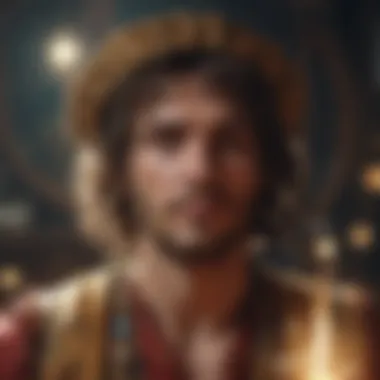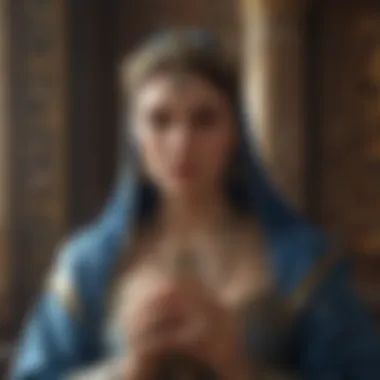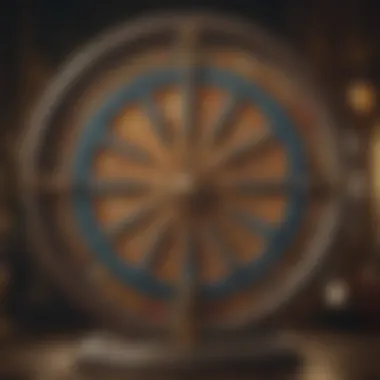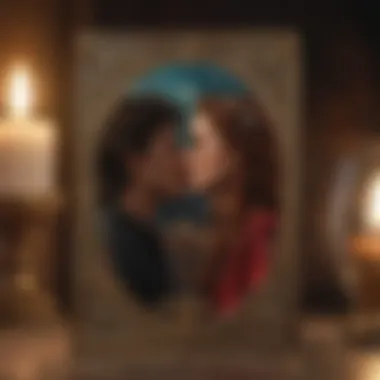The Meanings of Each Tarot Card: A Comprehensive Exploration


Intro
The exploration of tarot card meanings intertwines with various esoteric traditions, including astrological insights. This depth of knowledge serves to enrich one’s understanding of personal and collective human experiences. By examining both the individual tarot cards and their broader associations, we can unlock layers of meaning that apply to everyday life.
Understanding the significance assigned to each card offers a gateway for insightful readings. This comprehensive analysis aims to unravel not just the symbolism, but also how these images resonate with personal growth and spiritual journeys. Tarot serves those who seek clarity, guidance, and deeper mindfulness in a complex world.
Understanding the Zodiac
Overview of Zodiac Signs
The zodiac is a circular representation of the twelve astrological signs. Each sign comprises a distinct set of traits and attributes influenced by elemental forces. This foundational knowledge is crucial for interpreting tarot cards, as many share themes with zodiac energies.
Sign Traits and Characteristics
Each zodiac sign possesses unique characteristics:
- Aries: Courageous, determined, and passionate.
- Taurus: Reliable, patient, and practical.
- Gemini: Adaptable, communicative, and curious.
- Cancer: Protective, nurturing, and intuitive.
- Leo: Charismatic, creative, and confident.
- Virgo: Analytical, detail-oriented, and practical.
- Libra: Diplomatic, charming, and fair-minded.
- Scorpio: Intense, resourceful, and transformative.
- Sagittarius: Adventurous, optimistic, and freedom-loving.
- Capricorn: Disciplined, ambitious, and responsible.
- Aquarius: Innovative, unconventional, and humanitarian.
- Pisces: Compassionate, artistic, and sensitive.
The interplay of these traits with tarot cards can provide a multi-dimensional reading experience.
Elemental Qualities
Each sign is associated with one of the four elements: Fire, Earth, Air, and Water. This elemental connection influences how tarot cards might be interpreted in relation to personal energy and situations. For example, Fire signs often indicate action and enthusiasm, while Water signs relate to emotions and intuition. Understanding these qualities can enhance the depth of tarot readings.
Prelude to Tarot
Tarot serves as a profound tool for introspection and understanding. The purpose of this section is to lay the foundational knowledge of tarot's significance, including its history and structural components. This exploration enhances the reader’s ability to appreciate the multifaceted nature of tarot, especially for those who may be new to it or for seasoned users looking for greater insight.
History and Origin of Tarot
The origins of tarot can be traced back to the 15th century in Europe, though its roots are speculated to go deeper into earlier civilizations. Initially used as playing cards, the tarot evolved into a divinatory system during the 18th century. Its imagery and symbolism drew from various cultures and belief systems, creating a rich tapestry that reflects the complexity of human experience. Understanding this history provides context for the interpretations of the cards, enhancing their individual meanings.
Understanding the Structure of Tarot Decks
A tarot deck is typically composed of 78 cards, divided into two main categories: the Major Arcana and the Minor Arcana. Each of these categories plays a distinct role in readings, contributing unique insights into the aspects of life they represent.
Major Arcana
Major Arcana consists of 22 cards that symbolize significant life events and spiritual lessons. They are often viewed as the core messages of a tarot reading. Each card in this section carries profound meanings and reflects important universal themes. The presence of Major Arcana cards in a reading underscores the gravity of the situation being explored. This makes them an essential part of tarot studies.
Minor Arcana
The Minor Arcana, with its 56 cards, complements the Major Arcana by addressing everyday events and experiences. It is subdivided into four suits: Wands, Cups, Swords, and Pentacles. Each suit corresponds to different aspects of life and offers insights into the nuanced situations one may encounter. Thus, the Minor Arcana is crucial for a comprehensive understanding of a reading.
Suits and Their Significance
The suits within the Minor Arcana symbolize different elements and human experiences. Wands often relate to action and creativity, Cups to emotions and relationships, Swords to thoughts and conflict, and Pentacles to material matters and stability. Each suit enriches the tapestry of tarot interpretations, allowing readers to explore specific aspects of their life journey. The structure of these suits provides a clear framework, helping to navigate the complexities presented in tarot readings.
Understanding the structure of tarot decks aids in unraveling the intricate meanings behind each card, facilitating a deeper connection to one’s life events and spiritual journey.
Major Arcana Cards
The Major Arcana cards hold a significant position within tarot, representing profound life themes and spiritual lessons. Each card in this section conveys a strong archetype and carries deep meanings that can influence readings. Understanding these cards is essential for interpreting the core aspects of one's journey. They provide insights into challenges and opportunities faced in life, tapping into the subconscious and revealing truths that may not be readily apparent.
The Fool
The Fool is the first card in the Major Arcana. It symbolizes new beginnings, potential, and spontaneity. The imagery often depicts a young person standing at the edge of a cliff, with a small dog at their side. This card encourages taking risks and embracing the unknown. In a reading, The Fool often suggests the need for openness and a willingness to venture into uncharted territories. It serves as a reminder to trust your instincts.
The Magician
The Magician represents manifestation and resourcefulness. This card showcases an individual with one hand pointing to the heavens and the other to the earth. The symbols of the four suits are displayed on the table. The Magician's appearance in a reading inspires confidence and highlights the capacity to turn dreams into reality. It encourages using available resources wisely to achieve goals.
The High Priestess


The High Priestess embodies intuition, mystery, and the subconscious mind. Typical illustrations show a woman seated between two pillars, symbolizing duality. This card suggests a time for reflection and inner exploration. When drawn, it often calls for trusting one's instincts and looking beyond the surface. Knowledge may be hidden, and it encourages seeking wisdom from within.
The Empress
The Empress signifies fertility, abundance, and nurturing. She is often depicted in a lush environment, emphasizing nature and growth. This card suggests a connection to the earth and highlights the importance of nurturing not just oneself but also others. When this card appears, it often reflects a time of creativity and new projects, urging embrace of one's emotions and intuitive side.
The Emperor
The Emperor represents authority, stability, and structure. Often portrayed as a strong figure seated on a throne, this card embodies control and order. In a reading, The Emperor implies the need for discipline and setting clear boundaries. It encourages taking charge, especially in situations that require leadership and strategic thinking.
The Hierophant
The Hierophant signifies tradition, conformity, and spiritual guidance. This card usually depicts a religious figure offering wisdom. It often relates to educational institutions and spiritual communities. When drawn, it invites the querent to seek guidance from established sources. There is an emphasis on values and the importance of understanding one's beliefs.
The Lovers
The Lovers card symbolizes relationships, choices, and harmony. Depicted often as two figures, it reflects the significance of connections in life. In a reading, this card speaks about partnership and the choices that influence relationships. It emphasizes the balance between love and desire and the need for open communication.
The Chariot
The Chariot embodies determination, control, and willpower. It is often shown as a figure in a chariot being pulled by two opposing forces. This card signifies triumph over obstacles through confidence and direction. It encourages moving forward with a strong focus on goals, indicating that success is within reach despite challenges.
Strength
Strength represents courage, patience, and inner power. Typically illustrated with a woman and a lion, this card emphasizes the importance of showing strength through gentleness and compassion. In a reading, Strength encourages facing fears and finding resilience. It shows that true strength lies in understanding and controlling one's emotions.
The Hermit
The Hermit is a card of introspection, solitude, and inner guidance. Often depicted as an old man with a lantern, this card signifies a journey inward. It encourages taking time for reflection and seeking clarity on personal issues. This card suggests the value of finding solitude to gain better insight and understand one's path.
Wheel of Fortune
The Wheel of Fortune symbolizes cycles, change, and destiny. This card often portrays a wheel turning with various figures representing the changing nature of life. It signifies that life is filled with ups and downs. When drawn, it serves as a reminder that circumstances can change quickly, urging acceptance of whatever comes.
Justice
Justice represents balance, fairness, and accountability. Typically illustrated with a figure holding scales, it highlights decisions and moral values. This card in a reading often indicates the need for honesty and fairness in dealings. It invites consideration of consequences and seeks to ensure that actions align with one’s values.
Death
Death symbolizes transformation, change, and endings. Contrary to popular belief, it is not merely a sign of physical death; rather, it signifies the conclusion of one stage and the opportunity for new beginnings. When this card appears, it often indicates the necessity for letting go of the past to make way for future growth. Acceptance of change is crucial.
Temperance
Temperance embodies balance, moderation, and harmony. Typically depicted as an angelic figure mixing two elements, this card reflects the need for equilibrium in various areas of life. In a reading, it encourages finding a middle ground and practicing patience. Temperance serves as a reminder to blend different aspects of life in a harmonious way.
The Devil
The Devil symbolizes temptation, materialism, and restriction. This card often shows a figure bound to a materialistic life. It reflects the darker aspects of human nature, including addictions or unhealthy attachments. When this card appears in a reading, it encourages a confrontation with these aspects, prompting questions about what truly binds a person.
The Tower
The Tower signifies upheaval, chaos, and revelation. It is depicted as a tower struck by lightning, representing sudden disruptions. This card often appears when a significant change is imminent, shaking one’s foundations. The Tower urges embracing transformation and recognizing that this chaos may lead to new insights.
The Star
The Star represents hope, inspiration, and renewal. Often illustrated as a woman pouring water into a pool, this card signifies tranquility and a guiding light. When drawn, it invites the querent to believe in possibilities and remain open to healing experiences. The Star encourages nurturing dreams and fostering spirituality.
The Moon
The Moon symbolizes intuition, illusion, and the subconscious. Depicting a moonlit scene with various imagery, this card calls for exploring deeper emotions while remaining aware of uncertainties. It may suggest facing fears or concealed truths. In a reading, it encourages trusting one’s instincts amidst confusion.
The Sun


The Sun signifies joy, success, and vitality. It is often illustrated with a bright sun shining down on figures, reflecting positivity. This card in a reading brings messages of achievements and optimism. It encourages embracing life with enthusiasm and acknowledging accomplishments.
Judgment
Judgment symbolizes rebirth, reflection, and evaluation. Typically portrayed as a figure awakening from a slumber, this card highlights accountability and understanding past actions. When drawn, it often signifies a time for reflection and decision-making. It encourages considering lessons learned and moving forward.
The World
The World represents completion, fulfillment, and wholeness. Often depicted as a figure surrounded by a laurel wreath, this card signifies the end of a journey and the achievement of goals. In a reading, it encourages acknowledging progress and celebrating one’s journey. The World invites a sense of unity and connection with the universe.
Minor Arcana Cards
The Minor Arcana plays a crucial role in understanding the full scope of tarot readings. This section broadens the overall comprehension of tarot, revealing how daily experiences and challenges are reflected in these cards. While the Major Arcana deals with significant life events and karmic lessons, the Minor Arcana encapsulates the everyday interactions and situations that shape one’s life. Appreciating the nuances and meanings of these cards enhances the reader's ability to provide more insightful and accurate interpretations.
Overview of Minor Arcana
The Minor Arcana consists of 56 cards, divided into four suits: Wands, Cups, Swords, and Pentacles. Each suit reflects different aspects of life experiences. These cards provide a rich tapestry of insights and lessons to guide individuals through various situations. Understanding these distinctions is essential for anyone interpreting tarot, as they help in detailing the emotional, spiritual, and material dimensions of a person's journey.
Wands
Wands signify action, creativity, and ambition. They are often associated with the element of fire, representing energy and passion. The cards in this suit reflect personal growth, inspiration, and the pursuit of goals. When Wands appear in a reading, they prompt reflection on ambitions and the ways one can harness their inner drive. \n
Key Interpretations:
- Initiative and new beginnings
- Challenges that require courage
- Creative exploration and expression
Cups
Cups are the suit associated with emotions, relationships, and connections. Linked to the element of water, they delve into the realm of feelings and intuition. This suit often highlights love, feelings of fulfillment, and emotional stability. The Cups encourage individuals to examine their emotional wellbeing and the connections they foster with others.
Key Interpretations:
- Emotional experiences and interactions
- Intuition and self-reflection
- Relationships and interpersonal dynamics
Swords
Swords represent the element of air and embody intellect, communication, and conflict. They often highlight challenges and decisions that require careful thought. The cards can indicate clarity of thought but can also reflect struggle or conflict. An understanding of Swords assists readers in navigating mental challenges and decision-making processes.
Key Interpretations:
- Intellectual challenges and disputes
- Clarity of thoughts and ideas
- Outcomes that require difficult decisions
Pentacles
Pentacles focus on the material aspects of life, including finances, work, and physical wellbeing. Connected to the element of earth, this suit encourages a practical approach to situations and emphasizes stability and security. The meanings of Pentacles underline the importance of addressing material realities, making them essential for readers interested in career and financial readings.
Key Interpretations:
- Financial matters and career challenges
- Practical skills and responsibilities
- Material success and security
Understanding the Minor Arcana enriches the reading experience by bringing clarity to everyday matters, ensuring a well-rounded perspective alongside the powerful messages from the Major Arcana.
Interpreting Tarot Card Meanings
Understanding how to interpret tarot card meanings is crucial for anyone engaging with tarot. This section focuses on the methodology of interpreting the cards, which brings clarity and depth to readings. It is not merely about memorizing definitions but rather about developing a connection with the cards. There are specific elements that enhance this process, benefiting both the reader and the querent.
Developing Intuition
Developing intuition is foundational in tarot reading. Each card presents unique visual cues and symbols that resonate differently with every individual. As one becomes familiar with the symbolism inherent in the tarot, it fosters intuitive insights that lead to more personalized interpretations. To nurture this, it is beneficial to engage in regular meditation or practice journaling about personal interpretations of individual cards. Recognizing one’s emotional responses while handling the cards can also provide further layers of understanding.
“Intuition is a powerful tool; it helps bridge the conscious and subconscious.”
This process can transform a standard reading into a profound experience. Therefore, tarot practitioners should make an effort to cultivate their intuitive skills over time.


Contextualizing Readings
Contextualizing readings adds another dimension to card interpretation. Each card can convey different meanings based on its position in a spread or the specific question posed. For instance, a card indicating conflict may have a lighter or heavier significance depending on its surrounding cards.
When conducting a reading, consider the following:
- The Question: Understand the delimiter to focus your interpretation effectively.
- Card Position: Specific layouts can alter the meaning significantly.
- Relationship Between Cards: Observe how cards interact. A card can enhance or diminish another’s influence based on their juxtaposition.
By maintaining these considerations in mind, readers will experience a more rounded understanding of the querent's situation.
Reversals: What They Indicate
Reversals are a topic of debate among tarot practitioners. Often, the interpretation hinges upon whether the reader views reversals as negative or as an opportunity for insight. Cards drawn in reverse can indicate internalized aspects of issues, suggesting obstacles, blockages, or hidden factors.
For instance, The Lovers reversed might signify discord or a difficult decision in a relationship, while The Fool reversed could suggest carelessness or a lack of direction. It is important to consistently analyze the meanings of reversals in conjunction with the overall reading.
In summary, interpreting card meanings requires a balance of intuitive abilities, situational context, and an understanding of reversals. By honing these skills, tarot practitioners can offer more nuanced readings, enriching their practice and providing valuable insights to those seeking guidance.
Practical Applications of Tarot
Understanding how to effectively apply tarot cards in daily life is crucial for both personal and collective growth. Practical applications of tarot extend beyond mere fortune-telling. They can foster greater self-awareness and offer guidance in various life situations. Developing skills in tarot reading enables practitioners to explore the rich symbolism of the cards while also addressing real-life challenges.
Using Tarot for Personal Insight
Using tarot for personal insight allows individuals to gain clarity on their thoughts, emotions, and paths. Each card pulled during a reading serves as a mirror, reflecting inner feelings and thoughts that may otherwise remain subconscious. With regular practice, tarot can improve one’s ability to focus on personal goals and identify areas needing attention.
Some benefits include:
- Enhanced self-awareness
- Tools for reflection
- Decision-making support
- Emotional processing guidance
Consider integrating daily or weekly tarot pulls into your routine. For example, drawing one card each morning can set a tone for the day, while weekly spreads can help analyze patterns and progress over time.
Tarot for Relationship Analysis
Tarot cards are also powerful tools for exploring relationships. They can provide insights not only about one’s feelings but also those of others involved. By examining dynamics between partners, family members, or friends, participants can identify areas of conflict or harmony. This analysis can lead to improved communication and deeper understanding.
When conducting a relationship spread, pay attention to:
- Main influences: Cards may reveal underlying issues affecting the relationship.
- Communication styles: Discover how effectively partners express feelings.
- Potential outcomes: Understanding what actions may lead to positive or negative developments.
Overall, tarot fosters empathy and strengthens bonds by promoting open dialogue and introspection.
Integrating Tarot with Astrology
The integration of tarot and astrology offers enhanced layers of understanding and analysis. Both systems examine archetypes and patterns in human life. Combining these disciplines can lead to more nuanced interpretations.
When using tarot in conjunction with astrology, consider the following:
- Analyze the astrology of the individual: Natal charts can inform the interpretation of specific cards.
- Explore the elemental connections: Each tarot suit corresponds to a different element, which can tie back to astrological signs.
- Look at planetary influences: Certain cards may resonate more when planetary alignments are considered.
Such integration can deepen personal readings, offering multi-dimensional insights about potential challenges and opportunities.
Tarot is not merely about predicting the future; rather, it is a guiding tool to enhance understanding and awareness in the present.
Through these practical applications, tarot serves as a powerful resource for personal and relational insight while also linking to broader astrological frameworks.
The End
The conclusion of this article serves as a vital synthesis of the intricate tapestry that encompasses each tarot card's meanings, reinforcing their relevance in both personal and communal contexts. Understanding tarot's multifaceted nature allows individuals to reflect on their life choices, confront uncertainties, and strive towards personal growth.
The Role of Tarot in Contemporary Spiritual Practices
In recent years, tarot has gained significant traction as a tool for introspection and spiritual exploration. Many practitioners view tarot not just as a means of divination, but as a method to facilitate deeper understanding of oneself and the universe. This is particularly important in today’s fast-paced world, where the search for meaning and clarity is paramount.
Tarot bridges the gap between the finite and the infinite, providing insights that are often obscured in everyday life. By engaging with tarot, individuals can explore their inner landscapes, making sense of personal experiences and aspirations. Furthermore, it encourages practitioners to embrace intuition, fostering a sense of empowerment and self-awareness.
The importance of tarot in contemporary spiritual practices can be highlighted in several ways:
- Self-Reflection: Regular tarot readings prompt individuals to contemplate their lives. This meditation on the cards becomes a form of journaling, where one's thoughts and feelings find voice.
- Community Engagement: Tarot has become a communal practice. Group readings or tarot parties allow for shared insights, promoting a collective understanding of overarching themes.
- Holistic Integration: Many modern practitioners integrate tarot with other spiritual modalities, including astrology, numerology, and meditation, creating a richly layered approach to spiritual discovery.
- Therapeutic Use: Some therapists utilize tarot as a gentle tool to ignite conversations, assisting clients in navigating emotional complexities, fostering a supportive environment.
Engaging with tarot can lead to an enriched life experience, making sense of patterns, embracing possibilities, and reflecting on personal growth. As more people turn to tarot for guidance, it solidifies its place not just as an ancient tool but as a relevant element in modern spiritual practices. By decoding the symbolic language of tarot, individuals can embark on a journey of self-discovery and connection to the wider cosmos.







